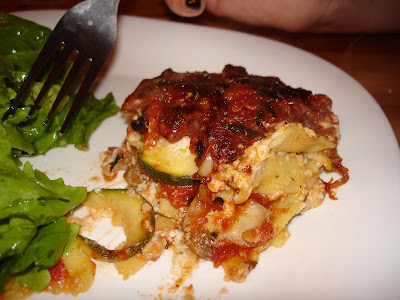
Ok, the last post was basically a maintenance post, just keeping everyone informed until something happened worth rhaposidizing. Well, one of the items in our shipment of gluten-free foods was lasagna noodles. In a fit of energy, we decided to make the
lasagna first. And (although those who know us will not be surprised) we decided not to settle for a simple lasagna, but to take it to a level worthy of the ingredients available to us here in France.
We've been trying to maintain a healthy diet and not to succumb too often to the secret of French cooking (butter, butter, and more butter), so we decided to included some zucchini we already had, some mushrooms (not as yet bought), some
"fresh" cheese (the closest available thing to
Ricotta cheese) and basil, basil, basil. Some elaborations:
Mushrooms...
It's mushroom season around here. While riding, Jeff will frequently see cars parked on the sides of roads near the forests. When he squints, he sees faintly visible, crouched figures creeping through the undergrowth, poking the ground with sticks, in search of fresh fungi. Equally frequently, there are signs posted forbidding the gathering of mushrooms. Of course, they are available at the farmer's market (in abundance), and at the local supermarket, which has been hit-or-miss; sometimes there are three or four varieties, and sometimes only one (typically the
Girolles from the United States). Yesterday, there was only one, but today there were three varieties, a good sign that the new ones would be fresh. Jeff was able to sniff the available selection with The Nose (pictured above) and decided on the mushrooms with the overwhelming odor of earthiness. So we got a handful of
trompettes de la mort (literally: trumpets of death) or
black trumpets.
Once all the ingredients were assembled, including the aforementioned basil (x3: homemade basil-and-garlic infused olive oil, dried basil, and fresh basil), we assembled our masterpiece.
The noodles took the most effort, as they like to stick together--always be sure to put a bit of olive oil in the boiling water, and to rinse the noodles in cold water after cooking! Here's our recipe:
Sauce:
1-2 tbs olive oil
3 cloves of garlic (chopped)
2 small red onions (chopped)
2 slices of cooked bacon (chopped)
2 cans crushed tomato
~1 pint white button mushrooms (sliced)
handful of fancy-schmancy mushrooms (chopped)
bay leaf (if you got it!)
[first saute the garlic and onion in the oil,
then add and steam mushrooms,
then add tomato, bacon, and bay leaf]
Zucchini:
slice up the zukes into wafers (they will form individual layers like the pasta)
Cheese:
usually lasagna calls for ricotta, but we're in France, so we improvised a cheese sauce out of fromage blanc, grated romano, gruyere, basil, rosemary, white wine, and a tbs of gluten-free flour
Noodles:
Precooked 'em for about 6 minutes, and spent another 10 trying to unstick them. They turned out fine, though :)
So, we lightly greased the casserole dish, layered the bottom with noodles, smoothed a layer of tomato sauce on, followed by a layer of zucchini, then cheese mixture, more noodles, tomato, etc. We topped it off with a sprinkle of romano and dried basil...
...with a spectacular result!
To go with this increasingly gourmet lasagna, we had visited the local
caviste (wine vendor)
Le Fruit Defendu, just
down the street from our apartment. The shopkeeper always gives very good recommendations. Besides suggesting wine that goes well with food (and we always tell him what we're having tonight, and which spices we're using), the wine is always interesting and tends to break away from the flavors traditionally associated with its type. In the case of our little lasagna, he suggested
Pechigo, an organic red wine grown near the Pyrenees in the south of France.

We can't wait to eat the leftovers tomorrow
(probably after we get home,
exhausted from the farmer's market).
Berlin in one week!!












